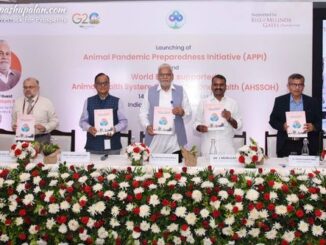FEW FACTS ABOUT Coronavirus disease (COVID-19)
Disease: Coronavirus disease (COVID-19)
Virus: Severe Acute Respiratory Syndrome Coronavirus 2 (SARS-CoV-2)/2019-nCoV
The current COVID-19 pandemic is caused by this virus. Coronaviruses (CoVs) are a large family of viruses, several of which cause respiratory diseases in humans, varying from the common cold to more serious diseases such as the Severe Acute Respiratory Syndrome (SARS) and the Middle East respiratory syndrome (MERS), both of which have high mortality rates and were detected for the first time in 2003 and 2012, respectively. A novel corona virus is a new strain (nCoV) that has not been previously identified in humans. As per WHO the mortality rate of COVID 19 is around 3.4%. This new corona virus seems to be more contagious than most strains of flu.
WHO announced “COVID-19” as the name of this new disease on 11 February 2020, following guidelines previously developed with the World Organisation for Animal Health (OIE) and the Food and Agriculture Organization of the United Nations (FAO).
ICTV (International Committee on Taxonomy of Viruses) announced “severe acute respiratory syndrome coronavirus 2 (SARS-CoV-2)” as the name of the new virus on 11 February 2020. This name was chosen because the virus is genetically related to the corona virus responsible for the SARS outbreak of 2003. While related, the two viruses are different.
Transmission
2019-nCoV is mainly transmitted via sick people through droplets (created when they talk, cough and sneeze), Close personal contact like touching or shaking hands (including self-infection caused by contaminated hands). Touching an object or surface with virus on it, then touching mouth, nose, eyes without washing hands.
Currently, the zoonotic source of SARS-CoV-2 is unknown. The first human cases of COVID-19, the coronavirus disease caused by SARS-CoV-2, were first reported from Wuhan City, China, in December 2019. At this stage, it is not possible to determine precisely how humans in China were initially infected with SARS-CoV-2. Although genetically closely related viruses have been isolated from bats, the exact source of SARS-CoV-2 and route of introduction into the human population has not been established.
Spillover Effect of Pandemic on Animal health sector
We may suspect that animal health will more likely be impacted by COVID-19, with human confinement and inactivity for shorter duration and economic crisis on animal sector related activity, farmer livelihoods and veterinary service capacities in longer timeframe. This may also negatively impact the control of animal diseases that are already present, as all activities has monetary implications thus it may adversely affect the surveillance efforts, ongoing testing schemes for endemic diseases.
Roles of Veterinarians in handling COVID 19 crisis
Keeping in mind the uncertainties of today’s world that is facing its worst ever crisis in form of Covid-19 pandemic, the roles and responsibilities of veterinarians are bound to change and in fact we vets are quite apt in taking the situations head on and quite skillfully, we have accepted the dual challenge of taking care of our animal health sector and are also addressing the requirements of working in tandem with the public health sector.
One Health Approach
It is based on the principle that disease management need to integrate human, animal and environmental perspectives. This pandemic is impacting both human and animal populations in numerous ways and thus underlines the importance of multi-sectoral collaboration, based on the principle of “One Health” approach, and therefore the sharing of expertise between medical and veterinary fraternity is the need of the hour.
Veterinarian response to the Covid-19 crisis
Veterinarian responses may include providing services and intersectoral expertise in handling this pandemic and it may also includes emphasis on implementing stricter Biosecurity measures.
Intersectoral expertise
- The unprecedented nature of this pandemic and yet to be done extensive research around this virus, it requires innovative approaches and in fact, beyond collaborative research, and being a part of common response, veterinarians are an integral part of the global health community and have a key role to play in disease prevention and management, specially zoonotic ones. Moreover, veterinarians have shown their commitment in supporting the work of human health authorities.
- Veterinary laboratories with their experience and expertise are engaged in activities such as surveillance screening, testing of human samples, thereby supporting and enhancing the diagnostic capacity of human health services.
- It is a matter of pride for entire Veterinary fraternity that many of our veterinary professionals across the globe have also been volunteering in hospitals and laboratories to work, hand in hand with medical fraternity where human resources were not sufficient.
- Some of the Veterinary epidemiologists and ecologists have been supporting their medical counterparts in tracking and tracing the disease in humans and thus not only assisting in improving collective understanding of SARS-CoV-2 but also helping in development of effective public health interventions. Veterinarians, especially in the field of immunology and molecular biology, are working at the forefront of the response at various levels.
- The adverse effects of COVID-19 on economies, animal health, and food security remain as significant as ever. Veterinary Services continue to address the food security and safety, as well as livelihoods of farmers (breeders and rearers), thus ensuring safe food provision for entire human populations.
General Biosecurity measures that needs to be followed at Farm level
Biosecurity is crucial to control and contain a disease such as COVID-19, as well as in the daily management practices, protecting the health of farm workers and animals.
- Restricted access to the premises and buildings where production animals, poultry etc. are kept.
- All personnel should stay home if they are sick.
- Increase distance between workers.
- Encourage personnel to use cloth face coverings.
- Encourage proper hand hygiene and provide workers with what they need to clean their hands.
- Clean and disinfect frequently touched surfaces.
- Where ever it is necessary to move to other farms, the personnel must clean their shoes and clothes.
- Minimize contact with sick or dead animals. If animals appear to be sick, wear gloves, face mask, and goggles or face shield when working with or near sick animals.
COVID-19 in the hindsight may be a blessing in disguise for the veterinary profession as it highlights the significance of two prong strategy, First is the principle of One Health approach, involving both human and animal experts and second is the need for the effective management of animal health and welfare during human pandemics.
One health approach underlines the importance of veterinary profession and gives veterinarians, an opportunity where they can help effectively in public health interventions. Effective management of animal health and welfare is more important than ever. Although, the risk of animals spreading SARS-CoV-2 to people is considered to be low but in today’s scenario of uncertainty where livelihood of millions of human population is at stake, we the Vets can play our role in improving the animal health infrastructure as it can very well caters to the basic need of food security, livelihood and businesses that are governed by animal health sector.
Myth busters
- People of all ages can be infected by the new corona virus.
- To date, except vaccination and some of the antiviral drugs, there is no specific medicine recommended to prevent or treat the new corona virus (2019-nCoV).
- This pandemic is being driven by person-to-person transmission. It is considered very unlikely that the animal would be a source of infection for the household. To date, reports of animals becoming infected with SARS-CoV-2 are typically cases of human to animal transmission, usually from an infected owner to their pet cat or dog. Based on the limited information available to date, the risk of animals spreading SARS-CoV-2 to people is considered to be low.





Be the first to comment